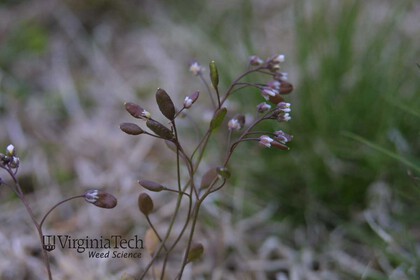spring draba
Family
BrassicaceaeScientific Name
Draba vernaSynonyms (former Scientific Names):
Erophila spathulata
Erophila verna
Draba praecox
Habit
This winter annual flowers from March through May. Plants are often problematic during turfgrass seedling establishment and may occur in large numbers during the spring after fall tillage.
Leaves
Plants are small and leaves form a basal rosette about 2 inches (5 cm) in diameter. Leaf margins are smooth or with occasional toothed indentations. Leaves are oblanceolate and tend to taper slowly toward the point of attachment.
Identifying Characteristics
Plants consist of small rosettes between the size of a quarter and half dollar and produce naked branched flowering stalks with tiny white flowers and flat green fruit. Unlike the other members of it's genus, Draba verna does not produce leaves on the flowering stems.
Flower Seed Head
The white flowers form on a long slender stem, and are 3 to 6 mm in diameter, with 4 petals. Flowering stems are many branched and do not have leaves.
Seed Fruit
Fruit is a silique or long slender fruit of the Brassicaceae family. Fruit are flat and not twisted like on related species. Fruit are 4 to 7 mm long and 2 to 3 mm broad and lack hairs. Fruit are initially green but turn brown in time. Each silique contains numerous ellipsoid seed that are 0.5 to 0.6 mm long.
Where Found
Plants are more commonly found in piedmont or mountain areas where they are naturalized in pastures, fields, forests, and other disturbed areas.
Growth Habit
upright and nonwoody
Thorns or Spines
not present
Approximate Flower Diameter
pencil
Dominant Flower Color
white
Flower Symmetry
bilateral symmetry
Leaf Hairs
has hairs
Leaf Shape
Varies:
lance,
oval
Leaf Arrangement
rosette
Leaf Margin
Varies:
entire,
serrated
Leaf Structure
simple
Leaf Stalk
shorter than leaf
Stem Hairs
no hairs
Stem Cross Section
round or oval
Milky Sap
not present
Root Structure
fibrous
Life Cycle
winter annual
Ochrea
not present
Plant Type
Herb











